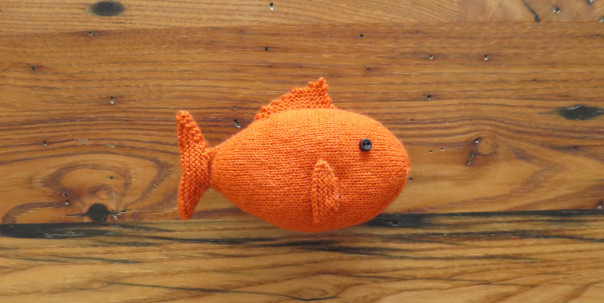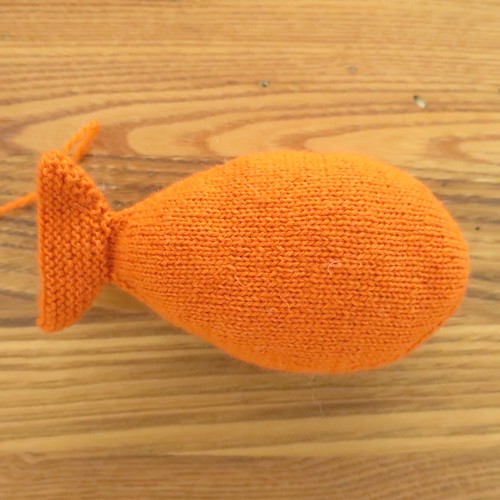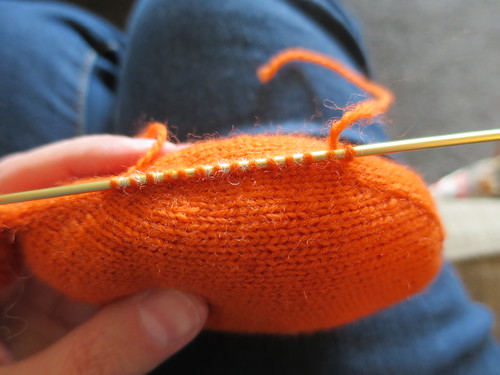Knitted Beautiful Fish
Crafted with care and creativity, these exquisite fish are brought to life through the art of knitting. Each stitch is carefully woven together, resulting in a stunning masterpiece that captures the beauty of the underwater world. The vibrant colors and intricate patterns of these knitted fish make them truly mesmerizing to behold. The attention to detail is evident in every scale and fin, as the knitted fabric mimics the graceful movement of real fish in water. These unique creations are not only visually appealing but also serve as a reminder of the artistry and dedication that goes into the craft of knitting. Whether displayed as decorative pieces or cherished as treasured keepsakes, these knitted fish are sure to captivate the hearts of all who encounter them.

Supplies:
- fingering weight yarn, about 30 yards (I used Knit Picks Palette in Orange)
- four double-pointed needles in a size appropriate to get a tight gauge (I used a size 0)
- stitch marker
- tapestry needle
- stuffing
- button, safety eye or embroider floss (If you are making this for a younger child I would recommend using safety or embroidered eyes)
Gauge:
Gauge is not important for this pattern, but you want to knit tight enough that the stuffing doesn’t show through. My gauge was about 10 stitches per inch and my fish was 5 ¼” long. More stitches per inch will give you a smaller fish, less stitches per inch will give you a bigger fish.
Abbreviations:
- k – knit
- p – purl
- ssk – slip, slip, knit
- k2tog – knit 2 stitches together
- p2tog – purl 2 stitches together
- m1l – make 1 stitch left
- m1r – make 1 stitch right
- bo – bind off
Tail:
Cast on 50 stitches. Divide between three needles. Join together to knit in the round being careful not to twist your stitches. Place a stitch maker between the first and last stitch to mark rows.
Row 1: p
Row 2: ssk, k21, k2tog, ssk, k21, k2tog (46 stitches)
Row 3: p
Row 4: ssk, k19, k2tog, ssk, k19, k2tog (42 stitches)
Row 5: p
Row 6: ssk, k17, k2tog, ssk, k17, k2tog (38 stitches)
Row 7: p
Row 8: ssk, k15, k2tog, ssk, k15, k2tog (34 stitches)
Row 9: p2tog, p13, p2tog, p2tog, p13, p2tog (30 stitches)
Row 10: ssk, k11, k2tog, ssk, k11, k2tog (26 stitches)
Row 11: p2tog, p9, p2tog, p2tog, p9, p2tog (22 stitches)
Row 12: ssk, k7, k2tog, ssk, k7, k2tog (18 stitches)
Row 13: p2tog, p5, p2tog, p2tog, p5, p2tog (14 stitches)
Row 14: k
Body:
Row 15: k1, m1l, k5, m1r, k2, m1l, k5, m1r, k1 (18 stitches)
Row 16: k
Row 17: k1, m1l, k7, m1r, k2, m1l, k7, m1r, k1 (22 stitches)
Row 18: k
Row 19: k1, m1l, k9, m1r, k2, m1l, k9, m1r, k1 (26 stitches)
Row 20: k
Row 21: k1, m1l, k11, m1r, k2, m1l, k11, m1r, k1 (30 stitches)
Row 22: k
Row 23: k1, m1l, k13, m1r, k2, m1l, k13, m1r, k1 (34 stitches)
Row 24: k
Row 25: k1, m1l, k15, m1r, k2, m1l, k15, m1r, k1 (38 stitches)
Row 26: k
Row 27: k1, m1l, k17, m1r, k2, m1l, k17, m1r, k1 (42 stitches)
Row 28: k
Row 29: k1, m1l, k19, m1r, k2, m1l, k19, m1r, k1 (46 stitches)
Row 30: k
Row 31: k1, m1l, k21, m1r, k2, m1l, k21, m1r, k1 (50 stitches)
Rows 32 – 33: k
Row 34: k1, m1l, k23, m1r, k2, m1l, k23, m1r, k1 (54 stitches)
Rows 35 – 36: k
Row 37: k1, m1l, k25, m1r, k2, m1l, k25, m1r, k1 (58 stitches)
Rows 38 – 39: k
Row 40: k1, m1l, k27, m1r, k2, m1l, k27, m1r, k1 (62 stitches)
Rows 41 – 60: k
Row 61: k1, ssk, k25, k2tog, k2, ssk, k25, k2tog, k1 (58 stitches)
Rows 62 – 63: k
Row 64: k1, ssk, k23, k2tog, k2, ssk, k23, k2tog, k1 (54 stitches)
Rows 65 – 66: k
Row 67: k1, ssk, k21, k2tog, k2, ssk, k21, k2tog, k1 (50 stitches)
Row 68: k
Row 69: k1, ssk, k19, k2tog, k2, ssk, k19, k2tog, k1 (46 stitches)
Row 70: k
Row 71: k1, ssk, k17, k2tog, k2, ssk, k17, k2tog, k1 (42 stitches)
Row 72: k
Row 73: k1, ssk, k15, k2tog, k2, ssk, k15, k2tog, k1 (38 stitches)
Row 74: k
Row 75: k1, ssk, k13, k2tog, k2, ssk, k13, k2tog, k1 (34 stitches)
Row 76: k
Start stuffing the body of the fish. Continue stuffing as you go along. If you are using safety eyes or sewing on eyes do it now.
Row 77: k1, ssk, k11, k2tog, k2, ssk, k11, k2tog, k1 (30 stitches)
Row 78: k1, ssk, k9, k2tog, k2, ssk, k9, k2tog, k1 (26 stitches)
Row 79: k1, ssk, k7, k2tog, k2, ssk, k7, k2tog, k1 (22 stitches)
Row 80: k1, ssk, k5, k2tog, k2, ssk, k5, k2tog, k1 (18 stitches)
Row 81: k1, ssk, k3, k2tog, k2, ssk, k3, k2tog, k1 (14 stitches)
Add anymore stuffing needed in the fish body. Cut your yarn leaving about a 10” tail. Place on a tapestry needle and weave through the 14 stitches on the needle. Remove needles and pull tight to close the hole. Weave in the end.
At this point you’ll have something that looks like a goldfish cracker.

Top Fin:
Pick up and knit 14 stitches along top of back of the fish body.

Row 1 – 4: k
Row 5: bo2, k11 (12 stitches)
Row 6: k
Row 7: bo2, k9 (10 stitches)
Row 8: k
Row 9: bo2, k7 (8 stitches)
Row 10: k
Row 11: bo4, k3 (4 stitches)
Row 12: k
Bind off remaining stitches
Weave in ends.
Side Fins:
Pick up and knit 5 stitches vertically on the side of the fish body. I placed mine a little bit below the middle and slightly towards the face.
Row 1: k
Row 2: k, m1l, k3, m1r, k (7 stitches)
Row 3: k
Row 4: k, m1l, k5, m1r, k (9 stitches)
Row 5: k
Row 6: k, m1l, k7, m1r, k (11 stitches)
Row 7: k
Row 8: k, m1l, k9, m1r, k (13 stitches)
Row 9 – 10: k
Bind off remaining stitches.
Repeat on the other side of the fish.
Weave in ends.
Seam the opening on the tail shut.